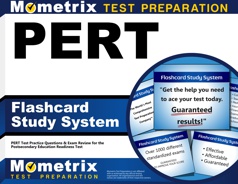The Postsecondary Education Readiness Test (PERT) is administered by the state of Florida to adequately assess your academic skills in mathematics, reading, and writing. How well you score on the exam will determine your placement into appropriate college courses.
Click the “Start Test” button above to begin our free PERT practice test! These practice questions will give you a better idea of what to study for your exam.
PERT Practice Tests by Subject
If you need some extra practice in a specific subject, click one of the subjects below to get started on a subject-specific PERT practice test.
PERT Exam Outline
The PERT is split into three sections: Mathematics, Reading, and Writing. Each section contains 30 questions, and you will have about 3 hours to complete the entire exam.
Here’s a closer look at each PERT section:
Mathematics
The PERT Mathematics test will assess your knowledge of equations, polynomials, coordinate planes, and more.
- Equations
- Evaluating algebraic expressions
- Polynomials
- Dividing by monomials and binomials
- Applying standard concepts or algorithms
- Coordinate planes
- Focusing on pairs of simultaneous linear equations in two variables
Reading
The Reading section of the PERT will assess your ability to determine word meanings, recognize relationships between sentences, and distinguish between facts and opinions.
- Discerning and summarizing important ideas and information
- Supporting or challenging assertions about a text
- Determining the meaning of words and phrases
- Analyzing the meaning, tone, and organizational structure of a text
- Determining an author’s purpose
- Determining the relation of events in a text
- Analyzing the traits and thoughts of fictional and nonfictional characters
- Analyzing how multiples texts address similar topics
- Distinguishing between fact and opinion
- Evaluating reasoning and rhetoric of an argument
Writing
The Writing section of the PERT will assess your ability to establish a topic/thesis, your usage of grammar and spelling, and your skills that pertain to conceptualizing and organizing ideas.
- Sustaining focus on a specific topic or argument
- Establishing a topic or thesis
- Demonstrating the uses of standard English writing conventions (grammar, mechanics, etc.)
- Developing and maintaining a style/tone
- Synthesizing information from multiple sources
- Conveying complex information clearly and coherently
- Representing and citing data, conclusions, and opinions
- Establishing a claim and acknowledging competing arguments
- Conceptual and organizational skills
- Word choice skills
- Sentence structure skills
- Grammar, spelling, capitalization, and punctuation skills
Check Out Mometrix's PERT Study Guide
Get practice questions, video tutorials, and detailed study lessons
Get Your Study Guide
Scores
How the Exam is Scored
The PERT is computer-adaptive, so depending on your performance, the difficulty of your test will increase or decrease as you go on.
Here’s a look at how it works:
The first question is judged to be of medium difficulty, and depending on your performance, the next question may be easier or harder. If you do well in the first question, the second question will be harder; conversely, if you do poorly on the first question, the second question will be easy.
The questions on the PERT test are rated on a scale of 50-150. The higher a question is rated, the harder the question is (e.g., a question marked as 63 will be easier than a question marked 112).
Receiving Your Scores
You will receive your PERT scores immediately after you finish the test. Your college will provide you with the final official score results.
Study Tips
How to Study Effectively
Your success on PERT test day depends not only on how many hours you put into preparing but also on whether you prepared the right way. It’s good to check along the way to see whether your studying is paying off. One of the most effective ways to do this is by taking PERT practice tests to evaluate your progress. Practice tests are useful because they show exactly where you need to improve. Every time you take a free PERT exam practice test, pay special attention to these three groups of questions:
- The questions you got wrong
- The ones you had to guess on, even if you guessed right
- The ones you found difficult or slow to work through
This will show you exactly what your weak areas are and where you need to devote more study time. Ask yourself why each of these questions gave you trouble. Was it because you didn’t understand the material? Was it because you didn’t remember the vocabulary? Do you need more repetitions on this type of question to build speed and confidence? Dig into those questions and figure out how you can strengthen your weak areas as you go back to review the material.
Answer Explanations
Additionally, many PERT practice tests have a section explaining the answer choices. It can be tempting to read the explanation and think that you now have a good understanding of the concept. However, an explanation likely only covers part of the question’s broader context. Even if the explanation makes sense, go back and investigate every concept related to the question until you’re positive you have a thorough understanding.
Comprehend Each Topic
As you go along, keep in mind that the PERT practice test is just that: practice. Memorizing these questions and answers will not be very helpful on the actual test because it is unlikely to have any of the same exact questions. If you only know the right answers to the sample questions, you won’t be prepared for the real thing. Study the concepts until you understand them fully, and then you’ll be able to answer any question that shows up on the test.
Strategy for PERT Practice
When you’re ready to start taking practice tests, follow this strategy:
- Remove Limitations. Take the first test with no time constraints and with your notes and PERT study guide handy. Take your time and focus on applying the strategies you’ve learned.
- Time Yourself. Take the second practice test “open book” as well, but set a timer and practice pacing yourself to finish in time.
- Simulate Test Day. Take any other practice tests as if it were test day. Set a timer and put away your study materials. Sit at a table or desk in a quiet room, imagine yourself at the testing center, and answer questions as quickly and accurately as possible.
- Keep Practicing. Keep taking practice tests on a regular basis until you run out of practice tests or it’s time for the actual test. Your mind will be ready for the schedule and stress of test day, and you’ll be able to focus on recalling the material you’ve learned.

PERT Online Prep Course
If you want to be fully prepared, Mometrix offers an online PERT prep course designed to give you everything you need to succeed!
Here’s what you’ll find in the PERT course:
- 50+ Review Lessons Covering Every Topic
- Over 500 PERT Practice Questions
- 200+ Video Tutorials
- 350+ Digital Flashcards
- Money-back Guarantee
- Mobile Access
Everyone learns differently, so we’ve tailored the PERT online prep course to ensure every learner has what they need to prepare for the PERT exam.
Click below to check it out!
Check Out Mometrix's PERT Flashcards
Get complex subjects broken down into easily understandable concepts
Get Your Flashcards
FAQs
Q
How many questions are on the PERT?
A
There are 90 questions in total on the PERT test (30 questions per subtest).
Q
How long is the exam?
A
The full PERT exam is timed at about 3 hours.
Q
What type of questions are on the PERT exam?
A
Every question on the PERT exam is multiple-choice.
Q
How much does the exam cost?
A
The cost to take the PERT exam varies widely depending on where you take it.
Q
What is a passing score on the PERT?
A
There is no set passing score for the PERT exam. Your final PERT score is simply used to determine which classes are best for you.



